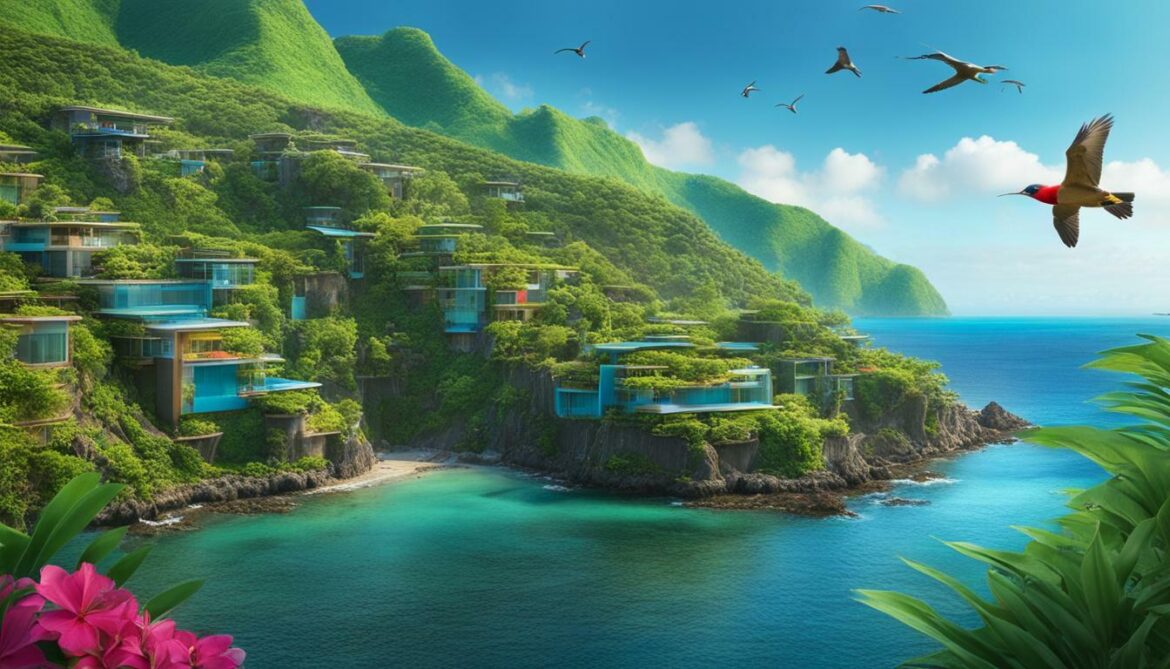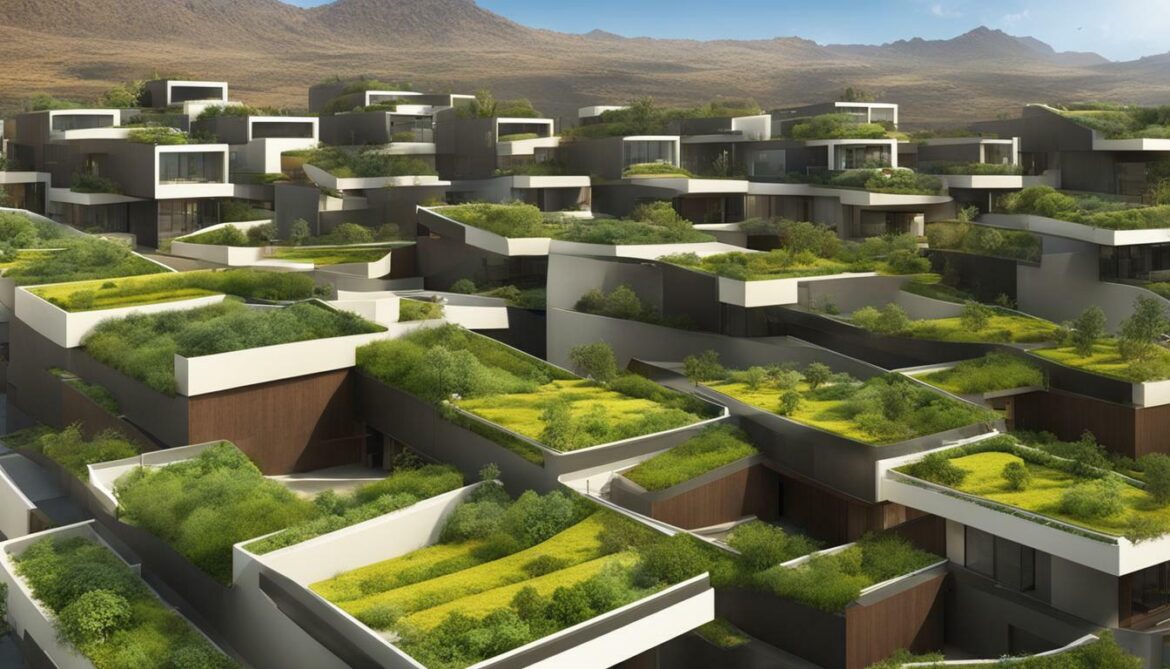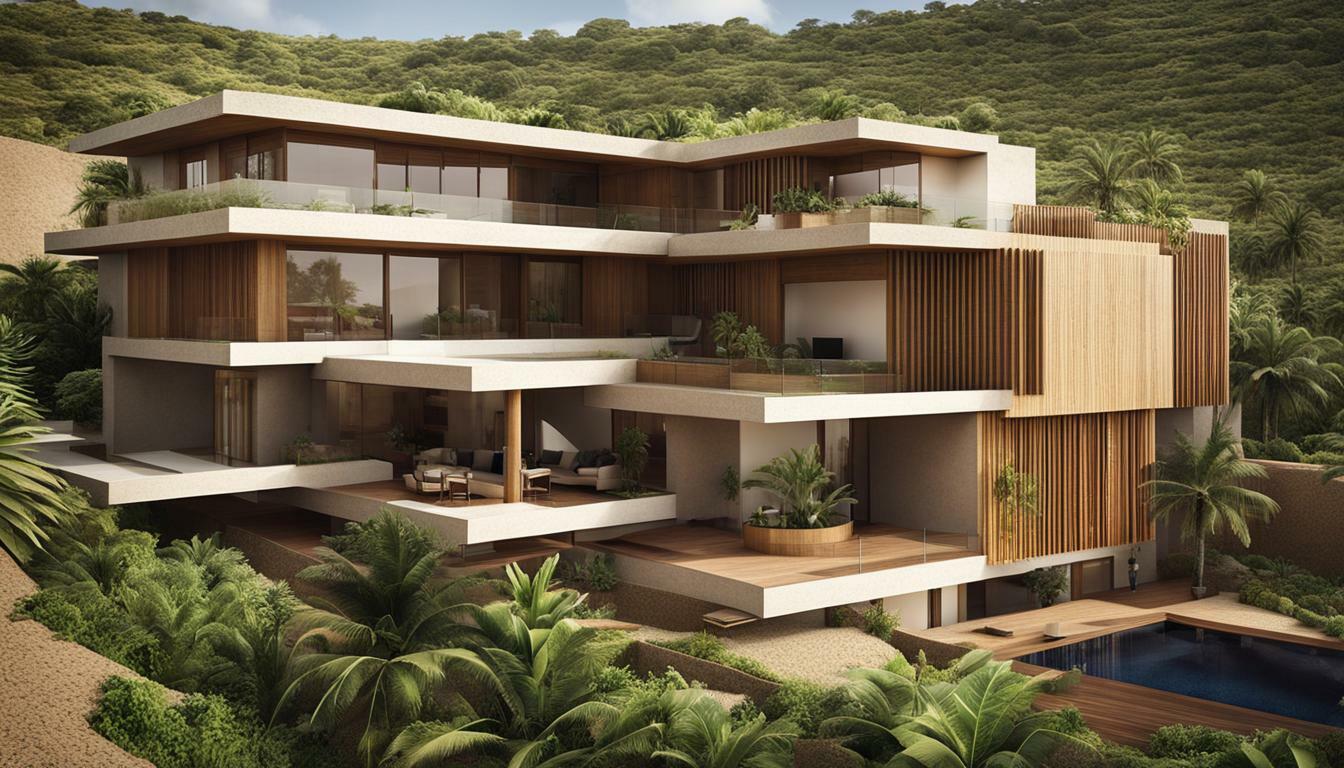Cape Verde’s commitment to sustainable construction practices has earned it a reputation as a leader in eco-friendly architecture. Over the years, the island nation has implemented various green building techniques that have helped to minimize the negative impact of buildings on the environment.
The principles of sustainability have been integrated into the architectural traditions of Cape Verde, resulting in a unique blend of modern design and traditional craftsmanship. From the adoption of renewable energy sources to the use of local materials, Cape Verde has made significant strides towards creating a more sustainable future.
This article will explore the green building history of Cape Verde, and highlight the impact of sustainability on the country’s architecture. We will delve into the specific green building techniques that have been employed, showcase innovative solutions and technologies, and examine the future prospects of sustainable construction practices in Cape Verde.
- Cape Verde is a leader in eco-friendly architecture
- The principles of sustainability have been integrated into the country’s architectural traditions
- Cape Verde has made significant strides towards creating a more sustainable future through the adoption of renewable energy sources and the use of local materials
- The country’s construction industry has been shaped by sustainable development goals and influenced design trends
- The future prospects of green building in Cape Verde look promising, with ongoing initiatives, policies, and innovations that aim to further promote sustainable construction practices
The Beginnings of Sustainable Construction in Cape Verde
Cape Verde is known for its commitment to sustainable development, as shown in its early adoption of environmental building practices. The country’s remote location and limited resources also necessitated a more sustainable approach to construction. Today, Cape Verde’s sustainable building practices continue to influence the wider construction industry, both locally and globally.
One of the key areas of focus in sustainable development has been the adoption of renewable energy sources. The country has abundant sunlight, making solar energy a viable alternative to traditional power sources. Local builders and architects have integrated solar panels into building designs, harnessing the power of the sun to provide electricity and hot water to buildings. This has significantly reduced the energy consumption and carbon footprint of many buildings in the country.
Another important area of focus has been water conservation. With limited freshwater resources, Cape Verde has pioneered the use of rainwater harvesting systems and wastewater recycling. These systems collect and reuse water, reducing the reliance on freshwater sources and minimizing waste. By implementing such systems, Cape Verde has become a leader in sustainable water management practices.
In addition to these practices, the integration of local materials in construction has also been a key factor in sustainable development in Cape Verde. The use of locally-sourced materials not only supports local economies but also reduces the environmental impact of transporting materials from afar. Local stone, volcanic rock, and adobe bricks are commonly used in building construction, providing a unique aesthetic and promoting sustainable building principles.
Overall, the early adoption of sustainable construction practices in Cape Verde has laid the foundation for a more environmentally-conscious construction industry. With innovative solutions and collaborations among the government, local businesses, and international partners, the country is set to continue leading the way in sustainable development.

Cape Verde’s sustainable construction practices have been shaped by the island nation’s unique architectural traditions, resulting in the emergence of eco-friendly architecture. This type of architecture prioritizes the use of sustainable building materials and techniques, as well as the implementation of environmentally conscious design principles.
Passive cooling techniques are a key feature of eco-friendly architecture in Cape Verde. Buildings are designed to take advantage of the island’s natural breeze, reducing the need for artificial cooling systems. Natural ventilation and shading strategies help to regulate interior temperatures, improving energy efficiency and reducing carbon footprint.
Another essential element of eco-friendly architecture is the use of natural light. Buildings in Cape Verde are designed to capture and distribute natural light, reducing the need for artificial lighting sources. This not only minimizes energy consumption but also provides a healthier and more comfortable living environment.

Green roofs and living walls are also becoming more popular in Cape Verde’s eco-friendly architecture. These features help to insulate buildings, reducing the energy required for heating and cooling. They also provide additional green space, which can help to improve air quality and promote biodiversity.
Eco-friendly architecture in Cape Verde is a testament to the country’s commitment to sustainable development. By prioritizing environmentally conscious design principles, architects and builders have created buildings that are not only beautiful but also contribute to the health of the planet. As Cape Verde continues to develop, it is hoped that eco-friendly architecture will become the norm rather than the exception.
Green Design in Cape Verde’s Buildings
Green design has become a fundamental aspect of Cape Verde’s buildings in recent years. Architects and builders have implemented innovative solutions and technologies to enhance energy efficiency while reducing the carbon footprint. The use of renewable energy sources such as solar panels and wind turbines has helped to reduce energy consumption, making buildings more sustainable and eco-friendly.
Customizable and smart building automation systems have also been installed to optimize energy consumption, making it more efficient and practical. Rainwater harvesting systems have been integrated, allowing buildings to collect and reuse water. This has significantly reduced the demand for water, particularly during periods of drought.
Another sustainable building practice that has gained traction in Cape Verde is the use of green roofs and living walls. Green roofs not only help to reduce heat absorption but also provide an additional layer of insulation for buildings. Living walls not only enhance the aesthetic appeal of the building’s exterior but also help to regulate indoor air quality by absorbing carbon dioxide and releasing oxygen.

Overall, the integration of green design in Cape Verde’s buildings has led to a significant reduction in energy consumption and carbon emissions. This has also resulted in lower utility bills for residents and businesses alike, making sustainable construction a cost-effective option in the long run.
The Impact of Sustainability on Architecture in Cape Verde
Architecture in Cape Verde has undergone a significant transformation in recent years, with a growing emphasis on sustainability and eco-friendliness. The country’s commitment to sustainable development goals has had a profound impact on the way architects and builders approach their work, resulting in innovative design solutions that prioritize the environment and local communities.
One key area where sustainability has influenced architecture in Cape Verde is the promotion of local craftsmanship. Traditional building methods and materials are being rediscovered and reimagined, with a focus on preserving cultural heritage while also incorporating modern design principles. This approach not only supports local economies but also ensures that buildings blend seamlessly with their surroundings.
Preservation of cultural heritage is not the only benefit of sustainable design in Cape Verde. The tourism industry is a major contributor to the country’s economy, and sustainable architecture plays a crucial role in promoting sustainable tourism. Buildings that are designed to minimize energy and water consumption, reduce waste, and incorporate renewable energy sources help to attract eco-conscious visitors and demonstrate Cape Verde’s commitment to a sustainable future.
Sustainability has also driven innovation in building materials and construction techniques, with a focus on reducing carbon emissions and minimizing waste. For example, builders are incorporating recycled materials and locally sourced materials into their projects, reducing the environmental impact of transportation and waste disposal. This approach not only benefits the environment but also supports local businesses and creates a sense of community pride.
The importance of sustainability in architecture cannot be overstated, and Cape Verde’s commitment to sustainable development sets an example for other countries to follow. By prioritizing eco-friendliness and incorporating local materials and craftsmanship, Cape Verde is not only creating beautiful and functional buildings, but also promoting a sustainable and prosperous future for its people.

In the next section, we will examine specific green building techniques that have been employed in Cape Verde, and how they contribute to sustainable development in the country.
Green Building Techniques in Cape Verde
Over the years, Cape Verde has implemented a variety of green building techniques to promote sustainable construction practices. These techniques not only benefit the environment but also contribute to energy efficiency and cost reduction. In this section, we will delve into some of the specific green building techniques employed in Cape Verde.
Passive Solar Design
Passive solar design is a technique that utilizes the sun’s energy to maintain a comfortable temperature inside buildings. In Cape Verde, buildings are constructed with large windows on the south-facing walls, allowing sunlight to enter and warm up the interior during the day. At night, the insulation in the walls and windows retains the warmth, thus reducing the need for artificial heating.

Natural ventilation systems are designed to circulate fresh air through the building using natural means. In Cape Verde, buildings are constructed with high ceilings and open windows to encourage natural air flow. This technique not only reduces the need for air conditioning but also improves indoor air quality.
Efficient Insulation Methods
Efficient insulation methods are employed in Cape Verde to reduce heat loss during the colder months and minimize heat gain during the hotter months. Builders use materials such as clay, straw, and cork to insulate walls and roofs, thus reducing the need for artificial heating and cooling.
These are just a few examples of the green building techniques used in Cape Verde. By adopting such practices, the country is promoting sustainable construction and setting an example for the rest of the world.
The Future of Green Building in Cape Verde
As Cape Verde continues to prioritize sustainable development, the future of green building looks promising. The government is implementing policies that incentivize eco-friendly construction practices and promote energy efficiency in buildings. In addition, international collaborations are paving the way for innovations in renewable energy integration and smart building automation.
Emphasis on education and awareness is also crucial for the success of sustainable construction in Cape Verde. As more people become informed about the benefits of eco-friendly architecture, they can contribute to the creation of sustainable communities and promote a greener future for the island nation.
One promising area of green building is the integration of renewable energy sources. Cape Verde’s abundant sunshine and windy conditions make it an ideal location for solar and wind power generation. With advancements in technology, buildings can now generate their electricity through the use of solar panels and wind turbines, reducing the reliance on fossil fuels and cutting down carbon emissions.
Another essential aspect of the future of green building in Cape Verde is the preservation of local craftsmanship and cultural heritage. By incorporating traditional materials and designs into sustainable construction practices, architects and builders can create buildings that reflect the country’s unique culture and history while promoting sustainable development.
The future of green building in Cape Verde is promising, but it requires ongoing efforts and collaborations among stakeholders. The construction industry needs to continue prioritizing sustainability and embracing innovations that enhance energy efficiency, reduce carbon footprint, and promote a greener future for the entire nation.

Cape Verde’s green building history has set a strong foundation for sustainable construction practices in the country. As the demand for environmentally conscious buildings continues to grow, the future of green building in Cape Verde looks promising.
Promoting Renewable Energy Integration
The government of Cape Verde has been proactively promoting renewable energy sources such as wind, solar, and hydropower. The island nation has abundant natural resources that can be harnessed to generate clean energy. As the technology continues to evolve, the integration of renewable energy in buildings will become more accessible and cost-effective.
Importance of Education and Awareness
Education and awareness are crucial to the success of sustainable construction in Cape Verde. Architects, builders, and policymakers need to be educated about green building techniques and their benefits. Public awareness campaigns can also help promote sustainable lifestyles, such as reducing energy consumption and waste production.
Role of International Collaborations
International collaborations can also play a significant role in promoting green building in Cape Verde. Knowledge-sharing and partnerships with international organizations can help bring new technologies and resources to the island nation. This can help further advance green building practices and accelerate the country’s sustainable development goals.
Conclusion
Cape Verde’s green building history has been a remarkable achievement. The country has managed to merge sustainable practices with its architectural traditions to create eco-friendly buildings that are both aesthetically pleasing and functional. The future of green building in Cape Verde is exciting, and ongoing efforts to promote sustainable construction practices will undoubtedly have a positive impact on the environment and the local community.
FAQ
What is the history of green building in Cape Verde?
The green building movement in Cape Verde emerged in response to the need for sustainable development and environmental conservation. It blends traditional architectural practices with modern eco-friendly techniques.
What are some sustainable construction practices in Cape Verde?
Cape Verde has adopted various sustainable construction practices, including the use of renewable energy sources, water conservation techniques, and the incorporation of local materials in building projects.
How does eco-friendly architecture contribute to sustainability in Cape Verde?
Eco-friendly architecture in Cape Verde focuses on minimizing the negative environmental impact of buildings. This includes implementing passive cooling techniques, utilizing natural lighting strategies, and incorporating green roofs and living walls.
How is green design integrated into buildings in Cape Verde?
Green design principles are applied in Cape Verde’s buildings to enhance energy efficiency and reduce carbon footprint. This includes the use of solar panels, rainwater harvesting systems, and smart building automation.
What is the overall impact of sustainability on architecture in Cape Verde?
Sustainability has greatly influenced the architecture of Cape Verde, shaping the construction industry and promoting design trends that prioritize local craftsmanship, cultural heritage preservation, and sustainable tourism.
What are some specific green building techniques used in Cape Verde?
Cape Verde utilizes various green building techniques, such as passive solar design, natural ventilation systems, and efficient insulation methods, to ensure energy efficiency and sustainability in construction projects.
What does the future hold for green building in Cape Verde?
The future of green building in Cape Verde looks promising, with ongoing initiatives, policies, and innovations aimed at further promoting sustainable construction practices. This includes the integration of renewable energy, education and awareness campaigns, and international collaborations.
Be sure to check out Cape Verde’s Top Green Buildings.
























Post comments (0)